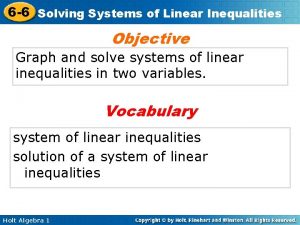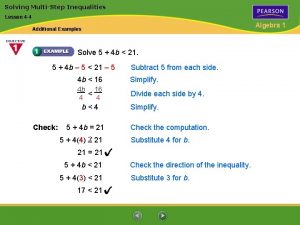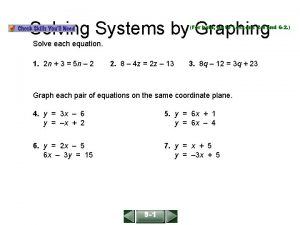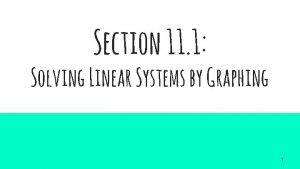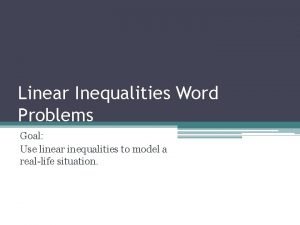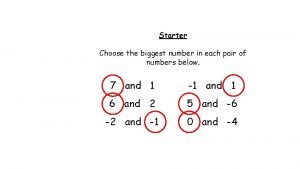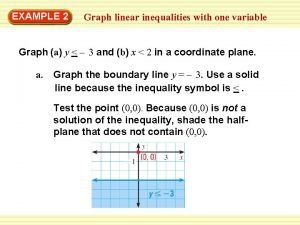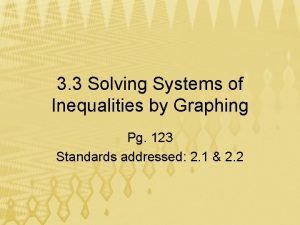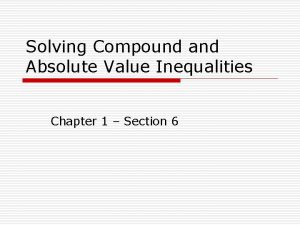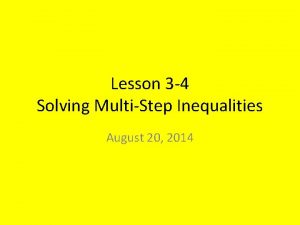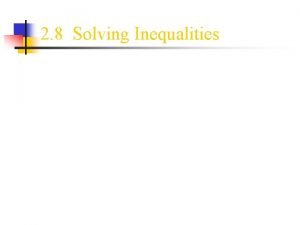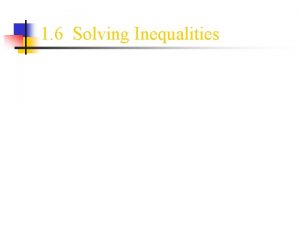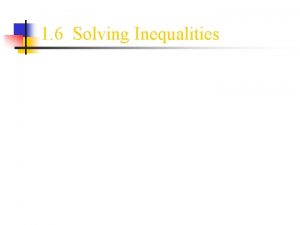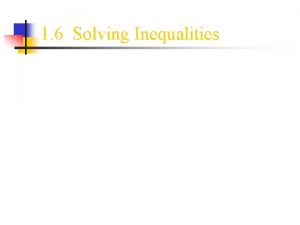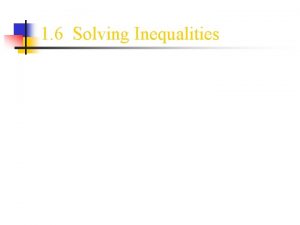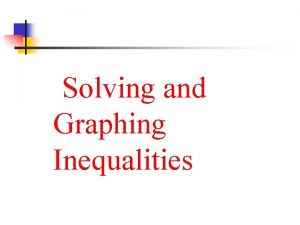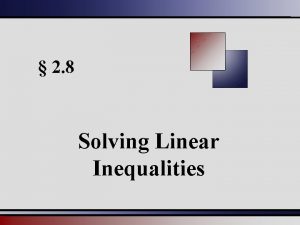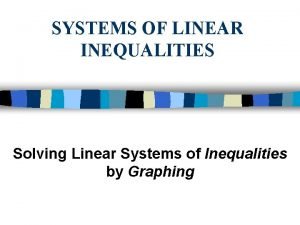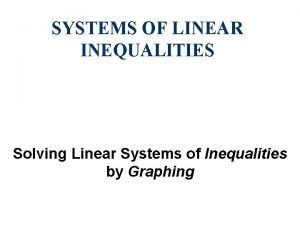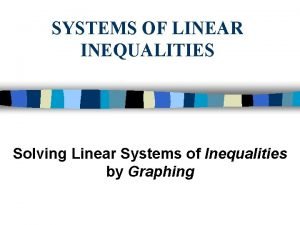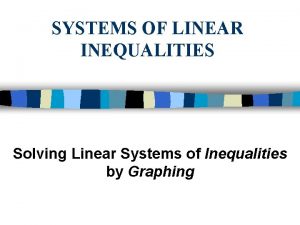Lesson 2 11 Solving Systems of Linear Inequalities



















- Slides: 19

Lesson 2. 11 Solving Systems of Linear Inequalities Concept: Represent and Solve Systems of Inequalities Graphically EQ: How do I represent the solutions of a system of inequalities? (Standard REI. 12) Vocabulary: Solutions region, Boundary lines (dashed or solid), Inclusive, Non-inclusive, Half plane, Test Point 1 2. 3. 2: Solving Systems of Linear Inequalities

Key Concepts • A system of inequalities is two or more inequalities in the same variables that work together. • The solution to a system of linear inequalities is the set of all points that make all the inequalities in the system true. • The solution region is the intersection of the half planes of the inequalities where they overlap (the darker shaded region). 2 2. 3. 2: Solving Systems of Linear Inequalities

Steps to Graphing a System of Linear Inequalities 1. Graph the first inequality as a linear equation. - Use a solid line for inclusive (≤ or ≥) - Use a dashed line for non-inclusive (< or >) 2. Shade the half plane above the y-intercept for (> and ≥). Shade the half plane below the y-intercept for (< and ≤). 3. Follow steps 1 and 2 for the second inequality. 4. The overlap of the two shaded regions represents the solutions to the system of inequalities. 5. Check your answer by picking a test point from the solutions region. If you get a true statement for both inequalities then your answer is correct. 2. 3. 2: Solving Systems of Linear Inequalities 3

Guided Practice - Example 1 Solve the following system of inequalities graphically: 4 2. 3. 2: Solving Systems of Linear Inequalities

Guided Practice: Example 1, continued 1. Graph the line y = -x + 10. Use a dashed line because the inequality is non-inclusive (greater than). 2. Shade the solution set. Since the symbol > was used we will shade above the yintercept. 5 2. 3. 2: Solving Systems of Linear Inequalities

6 2. 3. 2: Solving Systems of Linear Inequalities

Guided Practice: Example 1, continued 4. Find the solutions to the system. The overlap of the two shaded regions, which is darker, represents the solutions to the system: 5. Check your answer. Verify that (14, 2) is a solution to the system. Substitute it into both inequalities to see if you get a true statement for both. 7 2. 3. 2: Solving Systems of Linear Inequalities

Guided Practice: Example 1, continued ✔ 2. 3. 2: Solving Systems of Linear Inequalities 8

Guided Practice - Example 2 Solve the following system of inequalities graphically: 9 2. 3. 2: Solving Systems of Linear Inequalities

Guided Practice: Example 2, continued 1. Graph the line y = x – 10. Use a dashed line because the inequality is non-inclusive (greater than). 2. Shade the solution set. Since the symbol > was used we will shade above the yintercept. 10 2. 3. 2: Solving Systems of Linear Inequalities

11 2. 3. 2: Solving Systems of Linear Inequalities

Guided Practice: Example 2, continued 4. Find the solutions to the system. The overlap of the two shaded regions, which is darker, represents the solutions to the system: 5. Check your answer. Verify that (3, 3) is a solution to the system. Substitute it into both inequalities to see if you get a true statement for both. 12 2. 3. 2: Solving Systems of Linear Inequalities

Guided Practice: Example 2, continued ✔ 2. 3. 2: Solving Systems of Linear Inequalities 13

Guided Practice - Example 3 Solve the following system of inequalities graphically: 4 x + y ≤ 2 y ≥ -2 14 2. 3. 2: Solving Systems of Linear Inequalities

Guided Practice: Example 3, continued 1. Graph the line 4 x + y = 2. Use a solid line because the inequality is inclusive (less than or equal to). Change to slopeintercept form: y = -4 x + 2 2. Shade the solution set. Since the symbol ≤ was used we will shade below the yintercept. 15 2. 3. 2: Solving Systems of Linear Inequalities

Guided Practice: Example 3, continued 3. Graph the line y = -2 on the same coordinate plane. Use a solid line because the inequality is inclusive (greater than or equal to). Shade the solution set. Since the symbol ≥ was used we will shade above the yintercept. 16 2. 3. 2: Solving Systems of Linear Inequalities

Guided Practice: Example 3, continued 4. Find the solutions to the system. The overlap of the two shaded regions, which is darker, represents the solutions to the system: 4 x + y ≤ 2 y ≥ -2 5. Check your answer. Verify that (0, -1) is a solution to the system. Substitute it into both inequalities to see if you get a true statement for both. 17 2. 3. 2: Solving Systems of Linear Inequalities

Guided Practice: Example 3, continued ✔ 2. 3. 2: Solving Systems of Linear Inequalities 18

You Try! Graph the following system of inequalities 1. y ˃ -x – 2 y + 5 x ˂ 2 2. 19 2. 3. 2: Solving Systems of Linear Inequalities
 Bounded or unbounded graph
Bounded or unbounded graph Solving systems of linear inequalities quiz
Solving systems of linear inequalities quiz 6-6 solving systems of linear inequalities
6-6 solving systems of linear inequalities 5-3 solving multi-step inequalities
5-3 solving multi-step inequalities 1-5 solving inequalities answers
1-5 solving inequalities answers Inequalities warm up
Inequalities warm up Lesson 9.1 solving linear systems by graphing answer key
Lesson 9.1 solving linear systems by graphing answer key 11.1 solving linear systems by graphing
11.1 solving linear systems by graphing Solving inequalities involving absolute value
Solving inequalities involving absolute value Inequalities word problem
Inequalities word problem Solving linear inequalities hangman
Solving linear inequalities hangman Linear equation and inequalities
Linear equation and inequalities 1-2 lesson quiz solving linear equations
1-2 lesson quiz solving linear equations Solving linear inequalities hangman
Solving linear inequalities hangman Reintroducing inequalities
Reintroducing inequalities Graphing linear inequalities in one variable
Graphing linear inequalities in one variable Solving systems of inequalities by graphing
Solving systems of inequalities by graphing Solving systems of inequalities algebraically
Solving systems of inequalities algebraically How to solve compound absolute value inequalities
How to solve compound absolute value inequalities 3-4 solving multi-step inequalities answer key
3-4 solving multi-step inequalities answer key


